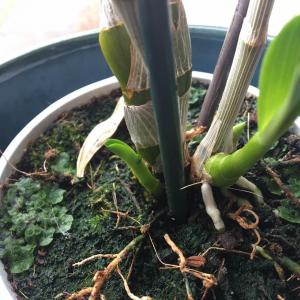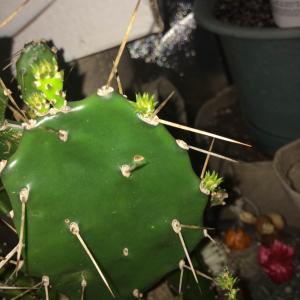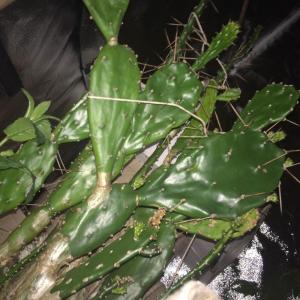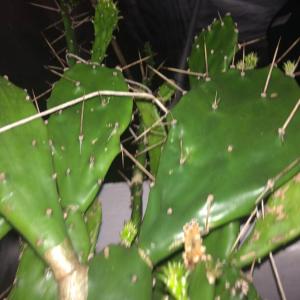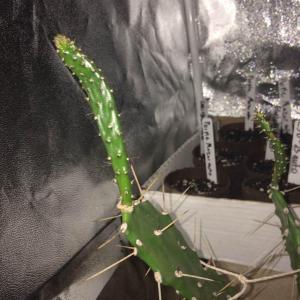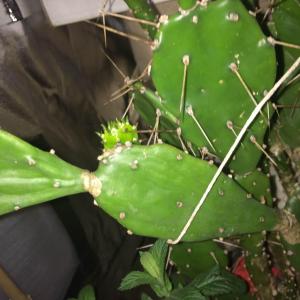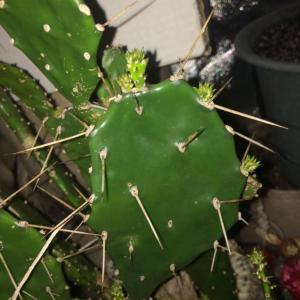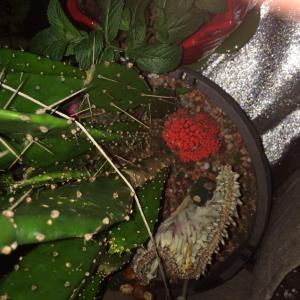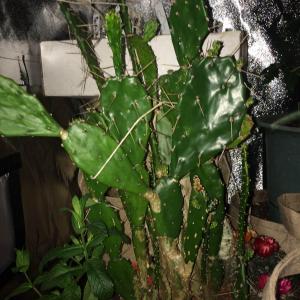求助
Lucky Coyote
2017年06月13日

Found these cute things growing in the wild, any ideas on what they are? It was growing at 3000ft, very cold area, and extremely wet (Salt Creek Falls, OR)
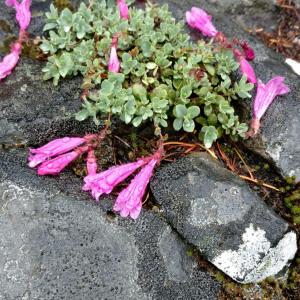

2
0
成长记
Cleaux
2017年06月07日

growing but strange
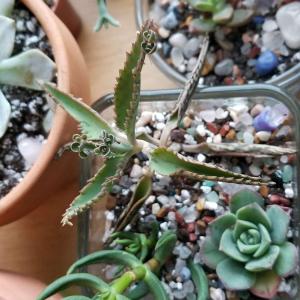
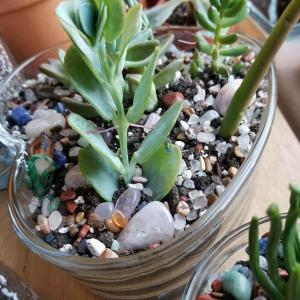
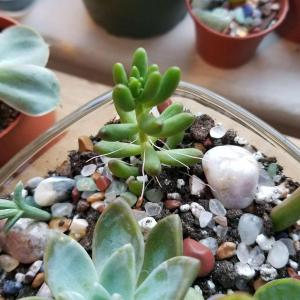



1
0
Cleaux:@Ueca thank you that's very helpful! any clue why the bottom leaves might be closing up on the spikey one?
Ueca:I've found that roots coming from branches above the soil means that it wants water.
成长记
Piothr
2017年06月06日

My lovely girlfriend's set of succulents is growing nicely! They seem to be very happy, and the "Dragon's Egg", which was a suprise find in one of the pots with a succulent we bought, has produced very long roots!
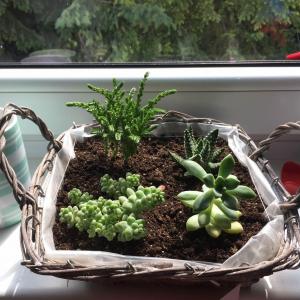
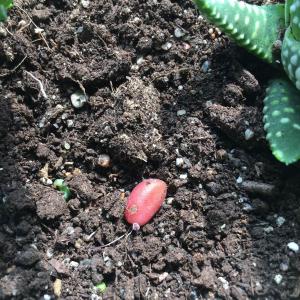
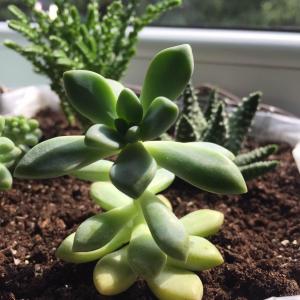
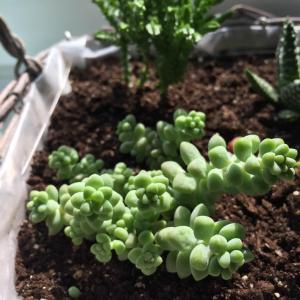
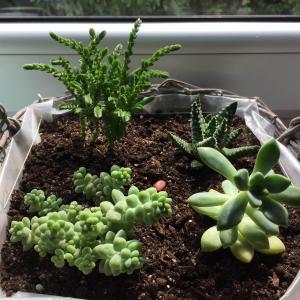





0
0
求助
Lauren
2017年06月01日

What am I growing in my front garden? #Identification #plant #succulent #Sedum


0
0
Lauren:@Hakunamatata that looks to be it thank you!
Hakunamatata:looks like Little Missy.
lizi_mayk
2017年05月31日

It's my new garden! I bought some new, and now are growing about 19 succulents!


0
0
文章
Gina
2017年05月27日
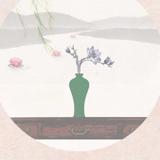
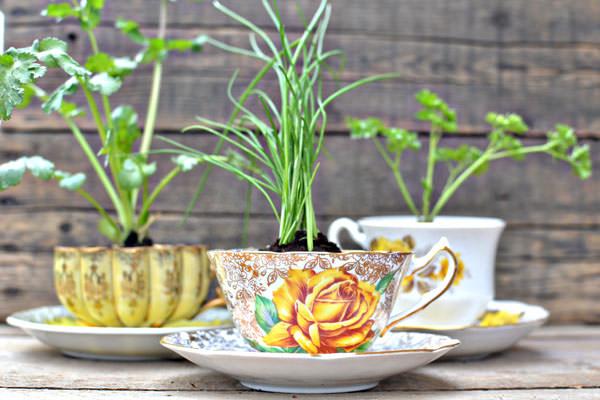
I love herbs, and growing them indoors is easy. Herbs add a texture, feel and scent to a room or a garden that is unlike any other plant. And, there is nothing like cooking with fresh herbs! But if you are like me, you like to do most things just a little bit different, so we found these DIY indoor herb garden projects and ideas that are just a cut above the usual terra cotta pots. (Not that there is anything wrong with that!) And in case you need a little guidance as well, some advice for which herbs grow well and how to maintain your herb garden indoors. Our featured photo above, is by Intimate Weddings. They have a step by step on creating this teacup herb garden.
Indoor Herb Garden Basics
Herbs generally require full sun, so you need to choose the placement of your herb garden well. A south facing window is ideal. As much bright light as possible is a key to success growing herbs inside, away from their natural environment.
Choose the right kind of herbs. Some herbs, such as basil, can be really tough to grow indoors because they really do need 6-8 hours of full sun each day, which is impossible to achieve in a window. Our favorite herbs to grow indoors include parsley, lemon balm, mint, chives and some varieties of thyme and oregano. The broader the leaf the better they do indoors. Lemon Thyme, or Doone Valley Thyme are favorites. In general, if an herb does well in partial shade outdoors, it will do well in a sunny indoor exposure.
Herbs need good drainage. Make sure you provide well draining soil and pots, and consider using gravel in the bottom for extra drainage. Adding a little grit or sand to the potting mix is great too. If you are using a container that tends to hold moisture, such as glass, use some activated charcoal in the bottom as well. (Sold in the houseplant section.)
Don’t overwater. Wait until the top inch of the soil is dry before watering most indoor plants. Overwatering is the number one killer.
Fertilize weekly with a weak liquid fertilizer for good growth, and remember to cut your herbs and use them! Cutting them back encourages new growth.
Now that you have the basics for growing herbs indoors down, here are some amazing projects we found to create one of a kind herb gardens.
This idea is an easy one…we suggest inserting small pots and liners into the drawers first if the piece you are using has any value…

This project is simply old tuna cans (painted if desired), with stained wood clothespins clipped onto the edges of the can. You can get these old style clothespins at the dollar store. See how they did this lovely project over at ‘7th House on the Left’.

Old tin cans and chalkboard paint, plus a little chain from the home improvement store…

Speaking of chalkboard paint, Breakfast with Audrey has this great tutorial on creating chalkboard herb garden pots. I love this, because you can reuse them each year for new herbs or plants, and the chalkboard gives it a vintage quality…

Another teacup herb garden by BHG, that has a more contemporary feel, but still homey…
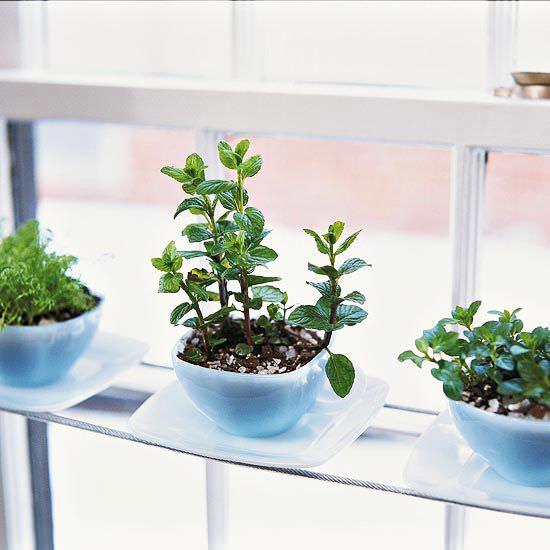
A great way to re-use this kitchen canister!
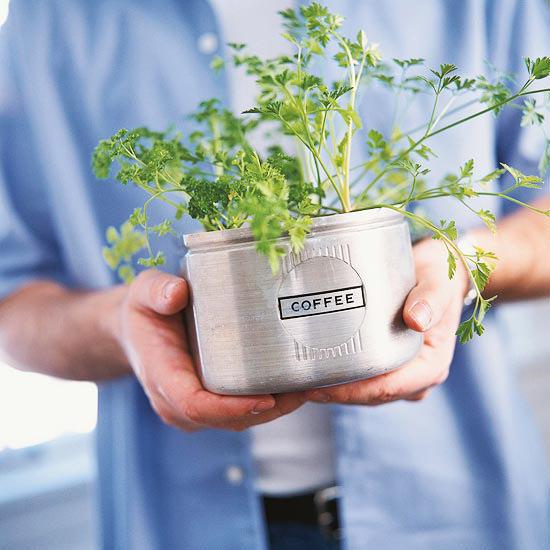
Sweet Paul Magazine has this great idea…Hang pegboard with s-hooks, and plant herbs in just a few of your coffee mugs! This is THE place to use charcoal and gravel in the bottom since they have no natural drainage, but talk about personality for the kitchen!

Paul Vitale, who designed the above project for Sweet Paul Magazine, also did this tin can herb garden. He simply attached cans to a piece of wood, then planted them.

From Funky Junk Interiors, this old kettle herb garden is a great repuposed project!
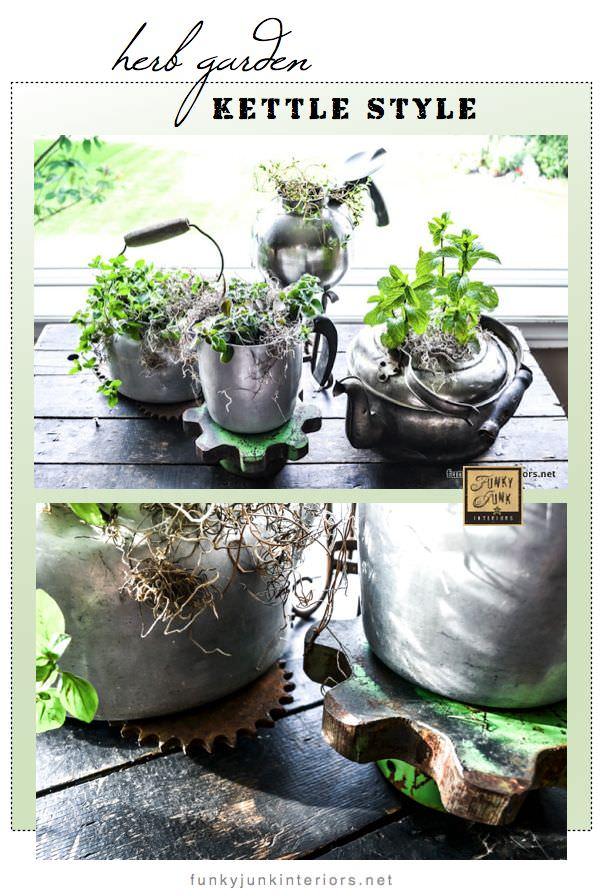
Finally, Apartment Therapy brings us this inspiration tea tin herb garden!

3
1
求助
Ueca
2017年05月26日

Can somebody verify if this is a Kalanchoe? Why are roots growing from the branches?
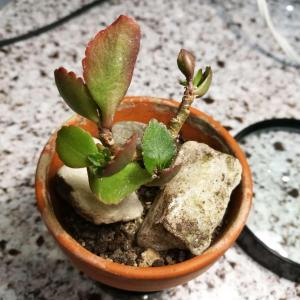
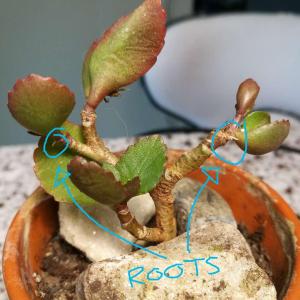


1
0
Ueca:I figured that was the case. Thanks.
Aesthesiiick:they seem to be aerial roots. when last did you water it ? remove the rocks and see if the soil is dry throughout , if it is then the plant might need some water
文章
lenny
2017年05月23日

Growing Banana trees in pots is easy, if you’re unable to grow it on the ground either due to lack of space or cold climate. Learn how to grow banana trees in this complete article.
There are banana varieties that can withstand temperature drops and grows well in containers, popular especially among the fans of exotic tropical plants in the garden.
The first question that may come up in your mind is– Will banana tree in a pot can bear fruits?
And the answer is yes. It is possible, a banana tree bears fruits in pot prolifically. It may take up to 3 to 5 years to fruit if grown from seeds.
Growing Banana Trees in Pots
Banana is a lush green, fast-growing plant that can give any place a tropical look and feel. Many varieties become excellent houseplants that don’t need much care and grow up very quickly.
Dwarf varieties of banana trees can grow anywhere between 2 to 4 meters. Compared to the ordinary banana trees that can reach up to 15 meters high.
Growing Banana Trees in Pots in Tropics
Growing banana tree in pot in a tropical climate is extremely easy, with little to no care banana tree grows in the container. If you’re living under USDA Zones 9 to 11, keep your banana tree in the shade in afternoon in summer, when the plant is young. All the other requirements are similar as given below in the article for temperate zones.
Banana Varieties you can Grow in Pots and Indoors
These dwarf varieties of banana tree restrict up to only 1.5 m to 4 m. (4 to 12 feet) tall and are suitable to grow in containers. You can also grow these banana varieties indoors.
Dwarf RedDwarf CavendishDwarf BrazilianDwarf JamaicanRajapuriWilliams HybridGran NainDwarf ‘Lady Finger’
If you would like to grow ornamental bananas check out these varieties:
Ensete ventricosumMusa sikkimensis ‘Red Tiger’Musa ornata
Also read: How to grow lemon in Pots
Requirements for Growing Banana Trees in PotsSun
Banana trees grow in tropical and subtropical parts of the world and therefore they love full sun, heat and humidity. If you’re growing banana tree you should keep it in a spot that receives the sun most of the day but preferably sheltered from the wind.
Soil
Growing Banana tree requires well-draining soil, sandy soil that is rich in organic matters and compost. Buy a good quality potting mix for your banana tree. If you are making it at home make sure to mix sand, perlite, and compost or manure.
Banana needs slightly acidic to neutral soil to produce those potassium rich nutritious bananas. The soil pH should be around 6 – 7. If your soil is alkaline mix sulfur to decrease the pH.
Watering
Banana loves moisture. Water it regularly and deeply but care not to overwater. In summer, water it every day. It may need water even two times a day in hot weather or when it is root bound. Soil for growing banana plants should be kept uniformly moist. Reduce watering in winter.
Banana Plant in Pot Care
Humidity
Banana plant prefers humidity levels above 50%. To increase humidity level around the plant, mist the plant and place it on a layer of pebbles in a tray filled with water.
Overwintering Banana Tree
Banana plants stop growing when the temperature drops below 50 ° Fahrenheit.
Before the onset of winter, do heavy mulching and prune the leaves.
Put it in a warm, bright room till the spring.
Fertilizer
Banana is a fast growing plant and it requires heavy feeding to grow at its full strength. Fertilize young plant when it establishes well with nitrogen-rich fertilizer to help it grow faster. Once your banana tree in pot becomes mature enough to produce fruit, fertilize it with 15:5:30 fertilizer regularly.
Pests and diseases
Bananas are quite resistant to diseases, still when you see the leaves turning brown and drying at the edges it means you’re overwatering and if the leaves turn yellow, banana plant is having a lack of nutrients.
Some pests that might attack banana plant are banana aphids, banana weevil, and coconut scale. These pests can easily be repelled using organic pesticides.

There are banana varieties that can withstand temperature drops and grows well in containers, popular especially among the fans of exotic tropical plants in the garden.
The first question that may come up in your mind is– Will banana tree in a pot can bear fruits?
And the answer is yes. It is possible, a banana tree bears fruits in pot prolifically. It may take up to 3 to 5 years to fruit if grown from seeds.
Growing Banana Trees in Pots
Banana is a lush green, fast-growing plant that can give any place a tropical look and feel. Many varieties become excellent houseplants that don’t need much care and grow up very quickly.
Dwarf varieties of banana trees can grow anywhere between 2 to 4 meters. Compared to the ordinary banana trees that can reach up to 15 meters high.
Growing Banana Trees in Pots in Tropics
Growing banana tree in pot in a tropical climate is extremely easy, with little to no care banana tree grows in the container. If you’re living under USDA Zones 9 to 11, keep your banana tree in the shade in afternoon in summer, when the plant is young. All the other requirements are similar as given below in the article for temperate zones.
Banana Varieties you can Grow in Pots and Indoors

These dwarf varieties of banana tree restrict up to only 1.5 m to 4 m. (4 to 12 feet) tall and are suitable to grow in containers. You can also grow these banana varieties indoors.
Dwarf RedDwarf CavendishDwarf BrazilianDwarf JamaicanRajapuriWilliams HybridGran NainDwarf ‘Lady Finger’
If you would like to grow ornamental bananas check out these varieties:
Ensete ventricosumMusa sikkimensis ‘Red Tiger’Musa ornata
Also read: How to grow lemon in Pots
Requirements for Growing Banana Trees in PotsSun
Banana trees grow in tropical and subtropical parts of the world and therefore they love full sun, heat and humidity. If you’re growing banana tree you should keep it in a spot that receives the sun most of the day but preferably sheltered from the wind.
Soil
Growing Banana tree requires well-draining soil, sandy soil that is rich in organic matters and compost. Buy a good quality potting mix for your banana tree. If you are making it at home make sure to mix sand, perlite, and compost or manure.
Banana needs slightly acidic to neutral soil to produce those potassium rich nutritious bananas. The soil pH should be around 6 – 7. If your soil is alkaline mix sulfur to decrease the pH.
Watering
Banana loves moisture. Water it regularly and deeply but care not to overwater. In summer, water it every day. It may need water even two times a day in hot weather or when it is root bound. Soil for growing banana plants should be kept uniformly moist. Reduce watering in winter.
Banana Plant in Pot Care

Humidity
Banana plant prefers humidity levels above 50%. To increase humidity level around the plant, mist the plant and place it on a layer of pebbles in a tray filled with water.
Overwintering Banana Tree
Banana plants stop growing when the temperature drops below 50 ° Fahrenheit.
Before the onset of winter, do heavy mulching and prune the leaves.
Put it in a warm, bright room till the spring.
Fertilizer
Banana is a fast growing plant and it requires heavy feeding to grow at its full strength. Fertilize young plant when it establishes well with nitrogen-rich fertilizer to help it grow faster. Once your banana tree in pot becomes mature enough to produce fruit, fertilize it with 15:5:30 fertilizer regularly.
Pests and diseases
Bananas are quite resistant to diseases, still when you see the leaves turning brown and drying at the edges it means you’re overwatering and if the leaves turn yellow, banana plant is having a lack of nutrients.
Some pests that might attack banana plant are banana aphids, banana weevil, and coconut scale. These pests can easily be repelled using organic pesticides.
4
2
文章
苍山洱海
2017年05月23日

Growing plants indoors can make your home look lively and lavish and if you too love that– Must see our 19 best DIY indoor garden decoration ideas!
If you too love indoor gardening (like we do!), learn about the arrangement ideas, DIY tricks and how you can maximize your planting space available indoors in this article.
1. Use Wall Mounted Storage to Keep Pots

The space between windows can also be prime real estate for growing, just like this one in the picture above. You can use wall mounted storage to keep the pots to decorate your home with plants.
2. DIY Pegboard Planter

This DIY pegboard planter project is simple, inexpensive, and easy to follow. If you want to see the step by step tutorial, visit brePURPOSED!
3. DIY Ladder Planter/Ladder Shelf

If you have got an old ladder, use it to keep pots in it. It can be made into an astonishing pot holder, perfect for growing indoor plants. A step by step tutorial is available on our site!
4. DIY Succulent Frame or Succulent Wall Planter

A DIY succulent frame or succulent wall planter is a great way to add a whim to your interior without spending a lot of money on materials you can make this. Here is the tutorial to follow.
5. Mason Jar Ideas

Upcycle mason jars can used to grow herbs. Here are some DIY ideas.
Mason jar can become adorable small pots and can be used to grow plants and herbs indoors. There are myriads of ideas available on the web to look for inspiration, you can look at one of our posts for more ideas!
6. Indoor Chair Planter

Not only outdoors, if you’ve got an old chair create an indoor chair planter and grow succulents or indoor plants on it to add a dramatic touch to your rooms. See more chair planter ideas!
7. Indoor Zen or Japanese Garden

An indoor Japanese or Zen garden can be a beautiful addition to your home when combined with a water feature, flowers of cool colors, stones, or succulents, a great way to add “calmness” to your home. You can also make a mini succulent zen garden in a pot, check out the tutorial here.
8. Flowering Houseplants

Decorate your indoor garden with flowering houseplants. They can add a bright touch to your home, growing them is similar to other indoor plants. Check out our article on best flowering houseplants here.
9. Use Plant Stands

Plant stand can not only increase your indoor planting space but also look elegant and decorate your home. The best thing about them is that you can also DIY them easily, here are some ideas.
10. Succulent Bookend
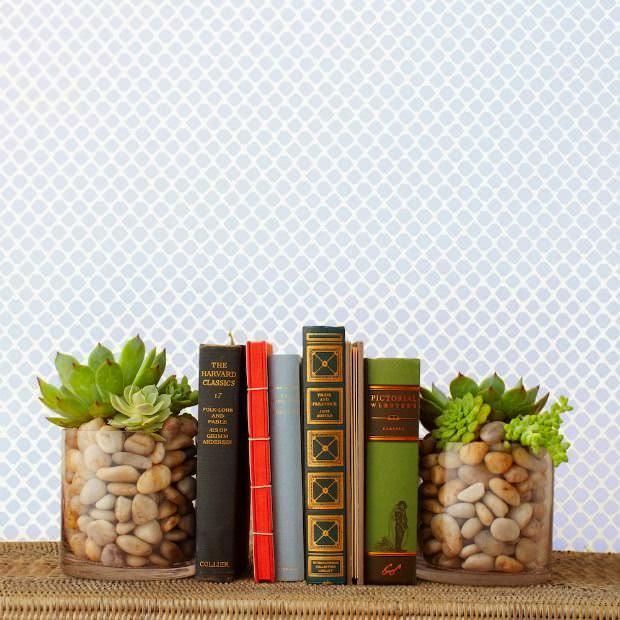
Prop up your favorite reads with this easy-to-make mini garden. Succulents are easy to grow. They add a welcome pop of greenery to any book collection when planted in clear vases filled with pretty river stones. See more of it here.
11. Hanging Coconut Planter
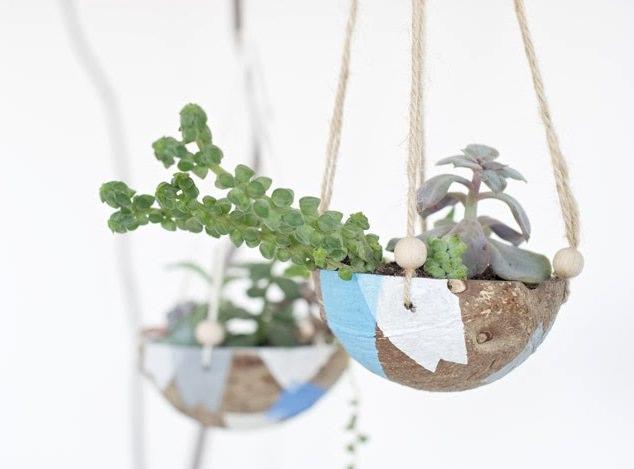
Use coconut shells after eating to create this super cute hanging indoor garden. This project is unique, still simple and doesn’t require much. Check out the tutorial here.
12. Sea Shell Planter
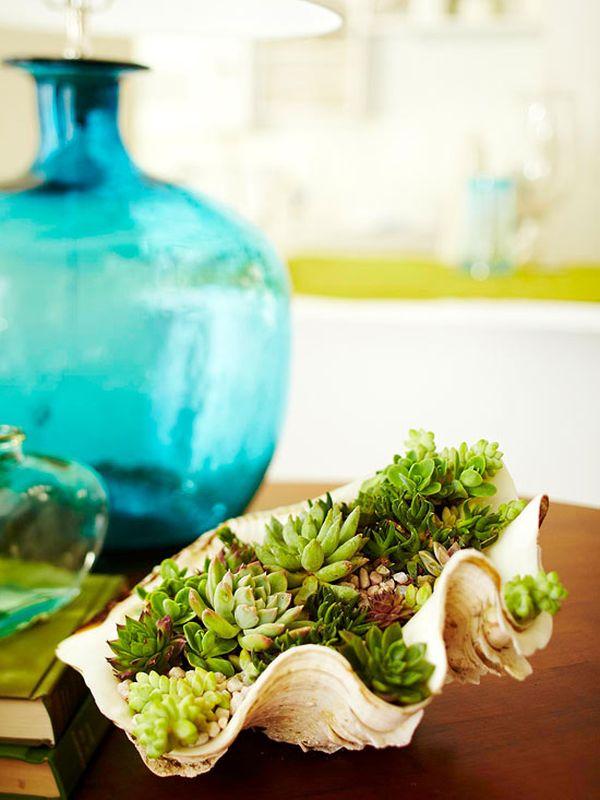
Sea-shell planters are creative ways to show off plants. You can tuck smaller succulents and use them as a centerpiece of your home. Check out these ideas!
13. Use Utility Cart to Hold Pots

Utility cart can be found in stores easily, it has many uses and one of them is this, especially if you’re short of space. Use it to hold planters.
14. Create an Indoor Fairy Garden

This well-planned fairy garden that resembles a gnome village (or many more other fairy garden ideas here) is looking amazing with colorful mushrooms, walkway, tiny houses, and banners.
15. Make a Succulent Dish Garden

Plant succulents in a dish and place it on the table top. It will make the focal point of the room. A complete DIY article on how to make a succulent dish garden is available here.
16. Plant Stand Room Dividers

Ikea plant stand (Socker series)
Plant stands can be used as room dividers, keeping cut beautiful cut flowers, herbs, and small plants. This way you’ll be able to maximize your growing space and create a division in a room too!
17. Keep a Plant Stand Near Window

Why just keep plants on a windowsill, let the plants use the sunlight comes from the windows by keeping a plant stand like this.
18. Teacup Herb Garden

Grow a herb garden in vintage teacups that you no longer use. Not only it will look good but this way you will be able to grow your own herbs. If you want to make a teacup planter too, here is the tutorial.
Also Read: Indoor Herb Garden Ideas
19. DIY Mosaic Pots

Take some of your old clay pots and turn them into astonishing mosaic pots. It’s easy! You’ll need a terracotta pot, vase filler chips or alternatively use pot shard or broken tile pieces. You’ll also need glue and spray paint. The first step is to paint the pot in your favorite color and leave it to dry. Once done, lie the pot and glue the chips or shards one by one. See more mosaic ideas!
If you too love indoor gardening (like we do!), learn about the arrangement ideas, DIY tricks and how you can maximize your planting space available indoors in this article.
1. Use Wall Mounted Storage to Keep Pots

The space between windows can also be prime real estate for growing, just like this one in the picture above. You can use wall mounted storage to keep the pots to decorate your home with plants.
2. DIY Pegboard Planter

This DIY pegboard planter project is simple, inexpensive, and easy to follow. If you want to see the step by step tutorial, visit brePURPOSED!
3. DIY Ladder Planter/Ladder Shelf

If you have got an old ladder, use it to keep pots in it. It can be made into an astonishing pot holder, perfect for growing indoor plants. A step by step tutorial is available on our site!
4. DIY Succulent Frame or Succulent Wall Planter

A DIY succulent frame or succulent wall planter is a great way to add a whim to your interior without spending a lot of money on materials you can make this. Here is the tutorial to follow.
5. Mason Jar Ideas

Upcycle mason jars can used to grow herbs. Here are some DIY ideas.
Mason jar can become adorable small pots and can be used to grow plants and herbs indoors. There are myriads of ideas available on the web to look for inspiration, you can look at one of our posts for more ideas!
6. Indoor Chair Planter

Not only outdoors, if you’ve got an old chair create an indoor chair planter and grow succulents or indoor plants on it to add a dramatic touch to your rooms. See more chair planter ideas!
7. Indoor Zen or Japanese Garden

An indoor Japanese or Zen garden can be a beautiful addition to your home when combined with a water feature, flowers of cool colors, stones, or succulents, a great way to add “calmness” to your home. You can also make a mini succulent zen garden in a pot, check out the tutorial here.
8. Flowering Houseplants

Decorate your indoor garden with flowering houseplants. They can add a bright touch to your home, growing them is similar to other indoor plants. Check out our article on best flowering houseplants here.
9. Use Plant Stands

Plant stand can not only increase your indoor planting space but also look elegant and decorate your home. The best thing about them is that you can also DIY them easily, here are some ideas.
10. Succulent Bookend

Prop up your favorite reads with this easy-to-make mini garden. Succulents are easy to grow. They add a welcome pop of greenery to any book collection when planted in clear vases filled with pretty river stones. See more of it here.
11. Hanging Coconut Planter

Use coconut shells after eating to create this super cute hanging indoor garden. This project is unique, still simple and doesn’t require much. Check out the tutorial here.
12. Sea Shell Planter

Sea-shell planters are creative ways to show off plants. You can tuck smaller succulents and use them as a centerpiece of your home. Check out these ideas!
13. Use Utility Cart to Hold Pots

Utility cart can be found in stores easily, it has many uses and one of them is this, especially if you’re short of space. Use it to hold planters.
14. Create an Indoor Fairy Garden

This well-planned fairy garden that resembles a gnome village (or many more other fairy garden ideas here) is looking amazing with colorful mushrooms, walkway, tiny houses, and banners.
15. Make a Succulent Dish Garden

Plant succulents in a dish and place it on the table top. It will make the focal point of the room. A complete DIY article on how to make a succulent dish garden is available here.
16. Plant Stand Room Dividers

Ikea plant stand (Socker series)
Plant stands can be used as room dividers, keeping cut beautiful cut flowers, herbs, and small plants. This way you’ll be able to maximize your growing space and create a division in a room too!
17. Keep a Plant Stand Near Window

Why just keep plants on a windowsill, let the plants use the sunlight comes from the windows by keeping a plant stand like this.
18. Teacup Herb Garden

Grow a herb garden in vintage teacups that you no longer use. Not only it will look good but this way you will be able to grow your own herbs. If you want to make a teacup planter too, here is the tutorial.
Also Read: Indoor Herb Garden Ideas
19. DIY Mosaic Pots

Take some of your old clay pots and turn them into astonishing mosaic pots. It’s easy! You’ll need a terracotta pot, vase filler chips or alternatively use pot shard or broken tile pieces. You’ll also need glue and spray paint. The first step is to paint the pot in your favorite color and leave it to dry. Once done, lie the pot and glue the chips or shards one by one. See more mosaic ideas!
2
3
文章
Colorful
2017年05月23日
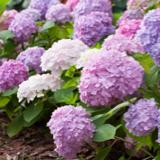
You love growing plants indoors, but they die soon (or you kill them)? This won’t happen again if you avoid these 9 mistakes!
Having plants in your house is like a baby to care. There are many things (if you’re new) you do not know when you plan to keep a plant in the house or the garden. If you are wondering WHY YOUR INDOOR PLANTS ARE DYING even after taking so much care and extra pampering, then there are some mistakes that you are doing. Here are the nine little (or the BIGGEST) mistakes which can kill your plant. So avoid doing them!
1. Keeping the plant in a location that is not suitable

Every plant has its specific needs, do’s and don’t do’s. If you don’t know what they are, acquire the knowledge from a florist, books or from the best place, the internet (consider our website)! Some plants are very specific with their placement indoor or outdoor. Placing them in an unsuitable location is certainly kill them sooner or later, quickly or gradually.
Mostly the plants growing indoors die due to this reason. You must read what a plant needs before you seek a place for it. Some plants require shade, indirect light or direct sunlight, while some need moisture. If a plant needs more level of moisture, then keep it in a shaded area. If not done so, all the moisture in the soil will dry up, and this will certainly kill the plant.
2. Changing the location to and fro
Plants adjust to the spot where they kept for a while, either at home or outdoors. When they moved often, it becomes difficult for them to adapt quickly to the different conditions of the new environment. Also, moving the plants frequently can hurt the growth of your houseplant.
3. Wrong soil
We say– Soil is the key! And when it comes to growing plants indoors, you can’t compromise with soil. A soilless potting mix is what we suggest. You can also make your own or choose high quality, organic soil mix.
Make sure that the soil you mix or buy is according to your plant’s needs. Some plants do better in moisture retaining, dense soil, while other plants, such as cacti, need light, fast-draining soil with high sand and peat content, to prevent root rot.
4. Overwatering

Even the experienced gardener make this mistake, this is the problem with container gardening. People who are new to gardening or growing plants do this– they think that giving more water to the plant will keep it healthy and let it grow faster. However, especially indoors, where the sun is scarce, the situation is different. Keeping plants on a little bit drier side is a good idea but if the plant you’re growing is a moisture loving plant then keep the soil slightly moist.
It is recommended that you do the research about the watering needs of your plant. Also, the most important factor that decides the watering requirements of a plant is the climate in which you’re growing it. Usually indoors, watering the plants only once a week should be enough though some of the low maintenance plants require even less water. It’s a good idea to feel the soil in every three days and when you water, water the plants thoroughly.
5. Keeping plants in too much or too little light
It is true that plants need light, but indoor plants are tender, low sunlight plants and exceeding their light requirement can kill them. It is always better to know about your plant before placing it anywhere. Some plants require little light for healthy growth. If they are supplied with more light, then this can kill or debilitate them.
6. Exposing to extreme temperatures
Indoor plants are indoor plants because they like indoor conditions and unvarying temperature, there are only a few that like high or low temperature than normal average room temperature. The safest daytime temperature for indoor plants is 65-75 F (18-24 C) or somewhere around it, whereas, during night time, fall in 5-10 F in temperature is optimum. Moderate temperature works well for houseplants and having a constant temperature leads to healthy growth.
7. Keeping the plant rootbound
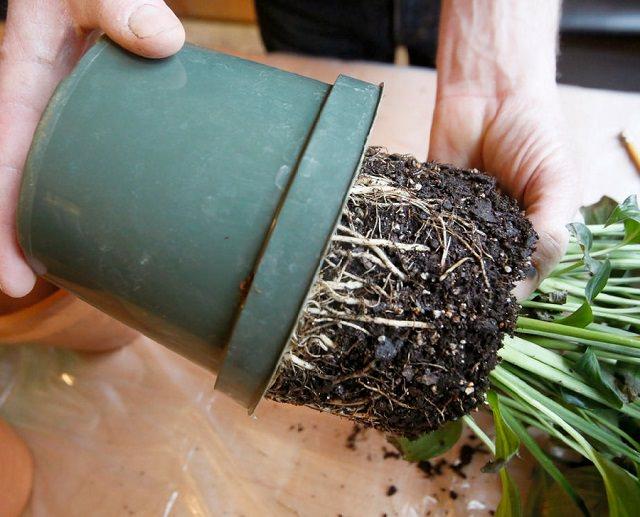
If you have a houseplant for a long time and you do not re-pot it then it, becomes bound to the pot you have planted it in. In optimum conditions, (if the plant is not slow-growing) plants outgrow the pot within a year or two. When leaves start to turn yellow or if you see the roots popping out, it is the signal to re-pot the plant. This indication is due to less space and freshness to grow healthy. When sending Plants for housewarming, you tend to gift it is small pot, but later it can be repotted in larger spaces.
Leaves turning yellow are the indication of insufficient space, water, nutrients and air. So when you see these signs, take the right step and re-pot the plant in a larger space.8. Neglecting the plants
Many of us, plant the plants and forget about them. Underwatering is one of the consequences of it. Neglecting plants is the reason why most people kill the indoor plants. Not looking at plants suffering from pests or diseases, missing to prune, no regular fertilization. All this must be avoided.
9. Not cleaning the leaves
Is it important to clean the leaves of the houseplants? Well, yes! For two reasons you should clean the leaves of your houseplants. First, it makes them look attractive. Second, it makes them HEALTHY! Already, the sun is scarce indoors, and the layer of dust accumulated on the foliage of houseplants contributes to blocking the direct or indirect sunlight and reduce the plant’s ability to photosynthesize. And a result you get a weak and stressful plant. Gardening Know How has an important article on this. Check out!
Having plants in your house is like a baby to care. There are many things (if you’re new) you do not know when you plan to keep a plant in the house or the garden. If you are wondering WHY YOUR INDOOR PLANTS ARE DYING even after taking so much care and extra pampering, then there are some mistakes that you are doing. Here are the nine little (or the BIGGEST) mistakes which can kill your plant. So avoid doing them!
1. Keeping the plant in a location that is not suitable

Every plant has its specific needs, do’s and don’t do’s. If you don’t know what they are, acquire the knowledge from a florist, books or from the best place, the internet (consider our website)! Some plants are very specific with their placement indoor or outdoor. Placing them in an unsuitable location is certainly kill them sooner or later, quickly or gradually.
Mostly the plants growing indoors die due to this reason. You must read what a plant needs before you seek a place for it. Some plants require shade, indirect light or direct sunlight, while some need moisture. If a plant needs more level of moisture, then keep it in a shaded area. If not done so, all the moisture in the soil will dry up, and this will certainly kill the plant.
2. Changing the location to and fro
Plants adjust to the spot where they kept for a while, either at home or outdoors. When they moved often, it becomes difficult for them to adapt quickly to the different conditions of the new environment. Also, moving the plants frequently can hurt the growth of your houseplant.
3. Wrong soil
We say– Soil is the key! And when it comes to growing plants indoors, you can’t compromise with soil. A soilless potting mix is what we suggest. You can also make your own or choose high quality, organic soil mix.
Make sure that the soil you mix or buy is according to your plant’s needs. Some plants do better in moisture retaining, dense soil, while other plants, such as cacti, need light, fast-draining soil with high sand and peat content, to prevent root rot.
4. Overwatering

Even the experienced gardener make this mistake, this is the problem with container gardening. People who are new to gardening or growing plants do this– they think that giving more water to the plant will keep it healthy and let it grow faster. However, especially indoors, where the sun is scarce, the situation is different. Keeping plants on a little bit drier side is a good idea but if the plant you’re growing is a moisture loving plant then keep the soil slightly moist.
It is recommended that you do the research about the watering needs of your plant. Also, the most important factor that decides the watering requirements of a plant is the climate in which you’re growing it. Usually indoors, watering the plants only once a week should be enough though some of the low maintenance plants require even less water. It’s a good idea to feel the soil in every three days and when you water, water the plants thoroughly.
5. Keeping plants in too much or too little light
It is true that plants need light, but indoor plants are tender, low sunlight plants and exceeding their light requirement can kill them. It is always better to know about your plant before placing it anywhere. Some plants require little light for healthy growth. If they are supplied with more light, then this can kill or debilitate them.
6. Exposing to extreme temperatures
Indoor plants are indoor plants because they like indoor conditions and unvarying temperature, there are only a few that like high or low temperature than normal average room temperature. The safest daytime temperature for indoor plants is 65-75 F (18-24 C) or somewhere around it, whereas, during night time, fall in 5-10 F in temperature is optimum. Moderate temperature works well for houseplants and having a constant temperature leads to healthy growth.
7. Keeping the plant rootbound

If you have a houseplant for a long time and you do not re-pot it then it, becomes bound to the pot you have planted it in. In optimum conditions, (if the plant is not slow-growing) plants outgrow the pot within a year or two. When leaves start to turn yellow or if you see the roots popping out, it is the signal to re-pot the plant. This indication is due to less space and freshness to grow healthy. When sending Plants for housewarming, you tend to gift it is small pot, but later it can be repotted in larger spaces.
Leaves turning yellow are the indication of insufficient space, water, nutrients and air. So when you see these signs, take the right step and re-pot the plant in a larger space.8. Neglecting the plants
Many of us, plant the plants and forget about them. Underwatering is one of the consequences of it. Neglecting plants is the reason why most people kill the indoor plants. Not looking at plants suffering from pests or diseases, missing to prune, no regular fertilization. All this must be avoided.
9. Not cleaning the leaves
Is it important to clean the leaves of the houseplants? Well, yes! For two reasons you should clean the leaves of your houseplants. First, it makes them look attractive. Second, it makes them HEALTHY! Already, the sun is scarce indoors, and the layer of dust accumulated on the foliage of houseplants contributes to blocking the direct or indirect sunlight and reduce the plant’s ability to photosynthesize. And a result you get a weak and stressful plant. Gardening Know How has an important article on this. Check out!
2
2
文章
Gina
2017年05月23日

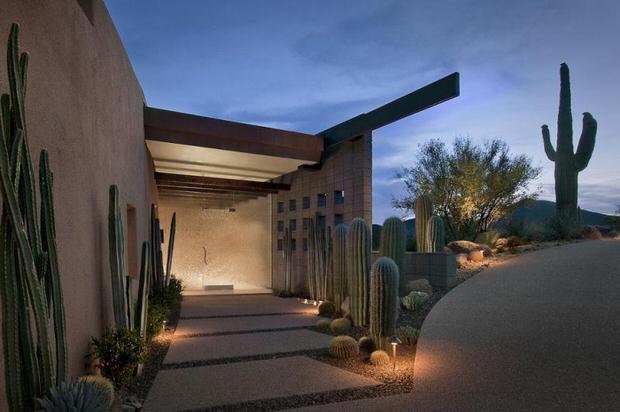
If your vision of growing cactus involves a dry desert look, think again. Cactus and succulents are one of the hottest garden trends going on right now, and we all should give them a little look. Live in a northern climate and don’t think you can grow them? We cover that too. Here’s how to grow cactus, and some great inspiration in using them as a modern design element to update any garden or landscaping .
Basics Needs of Cactus
First of all, when most of us think of cactus, we think of the varieties meant for desert environments. While there are many beautiful ones that grow down south, most people don’t know that there are several hardy varieties as well. Check with your local nursery, then check out our guidelines for growing in northern gardens. So number one is that they need to be well matched with their planting zone.
Second, all cacti need well drained soil. Grow them in a mix of 50 percent soil to 50 percent coarse sand. If growing in containers, use a commercially available cacti mix.
They need very little water. If you live in an area that gets rain in the summer, than that is probably all they need. If they grow in containers, let them dry out completely before watering.
They need little fertilizer. For blooming varieties, you may wish to give them a diluted drink of liquid fertilizer just as they start setting buds.
They need full sun. Duh.
Growing them in the North
So the only trick to growing cacti in the north is to grow the proper varieties. Better Homes and Gardens has a good article on just that right here.
Contain Your Cactus
If you don’t want to be held back by your climate, keep in mind cacti do well in containers. They can be brought inside during the winter to a sun room or other bright warm space. Three tips for you…
Use gloves. Another duh.
Use a well drained soil mix made for cacti.
Don’t over water.


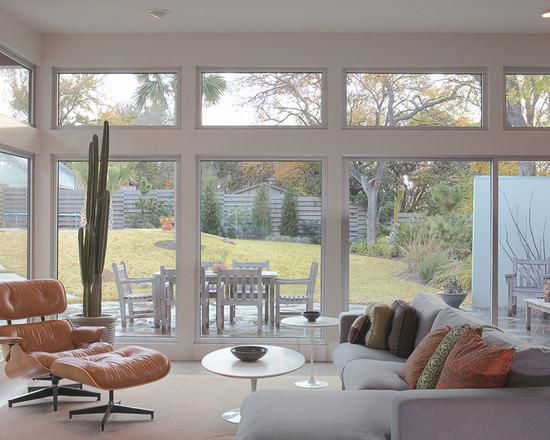
Texture, Design and Interest
So here is where the appreciation for cacti comes in. Fewer plants on this earth have such amazing adaptive qualities. They are a lesson in form and function, in the beauty of Mother Nature and a lesson in her harshness as well. Used in a repeat pattern they are an exceptional design element. Nothing adds more texture and interest to a garden. Aren’t convinced? Check out these inspiring photos.

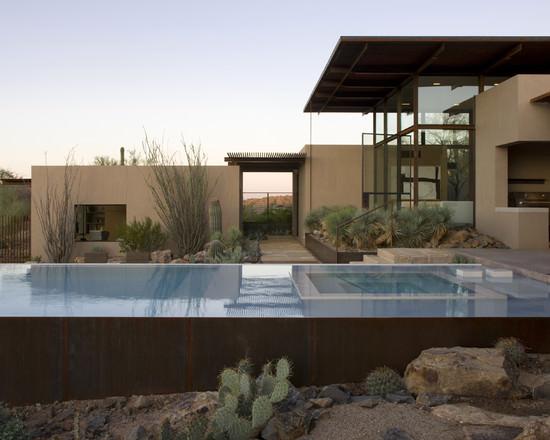


Growing cactus can be an adventure in modern gardening, and can be the beginning of a whole new obsession no matter where you live!
0
0



